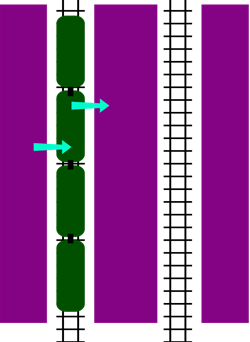Cross Platform Interchange - No Escalator Rides ☹

In a metro system with multiple lines, usually a person transfers from one line to another to reach their destination. A station where one can transfer is called an interchange. In an interchange, normally the lines are stacked one above the other. This means one must use stairs, escalators or lifts to interchange between lines. A cross-platform Interchange ( CPI ) is a type of interchange, where changing from one line to another means just walking across the same platform and does not require usage of stairs, escalators, or lifts. When two lines cross each other, there is a maximum of 8 possible ways to transfer between lines. I will look at some interesting station designs which enable easy cross-platform interchange Island platforms play an important role in enabling CPI. Full CPI or Paired stacked-island cross-platform This supports all possible interchange movements. This requires two stations. Each Station has two island platforms stacked one above the other.

